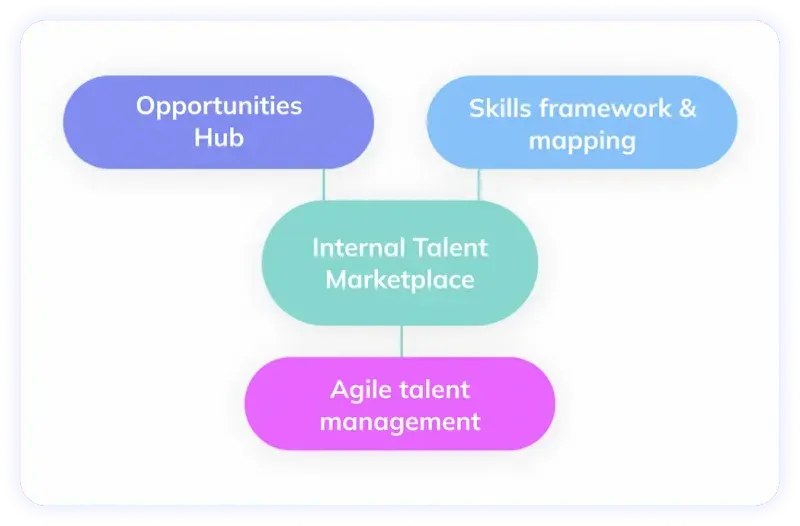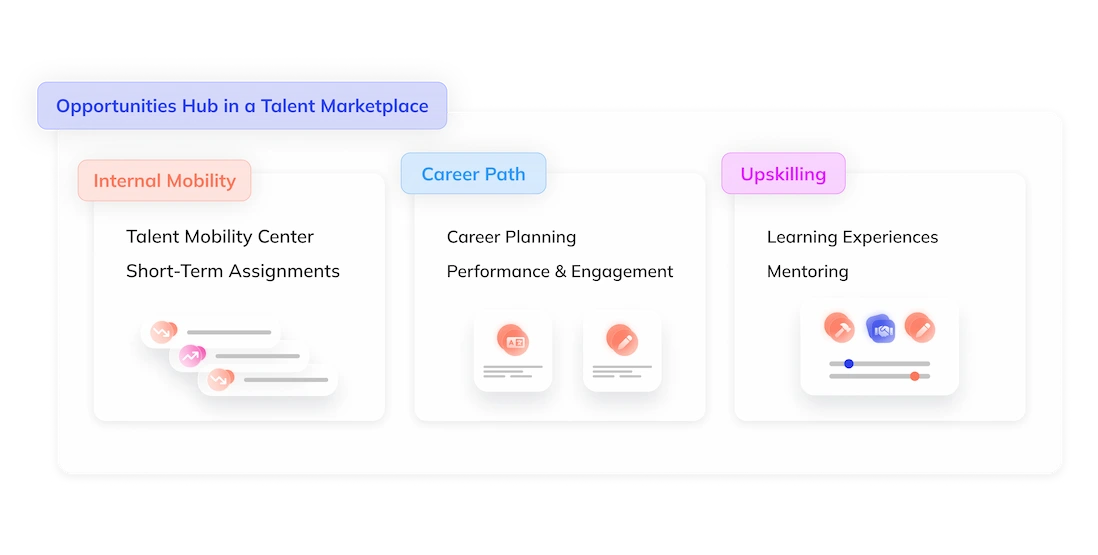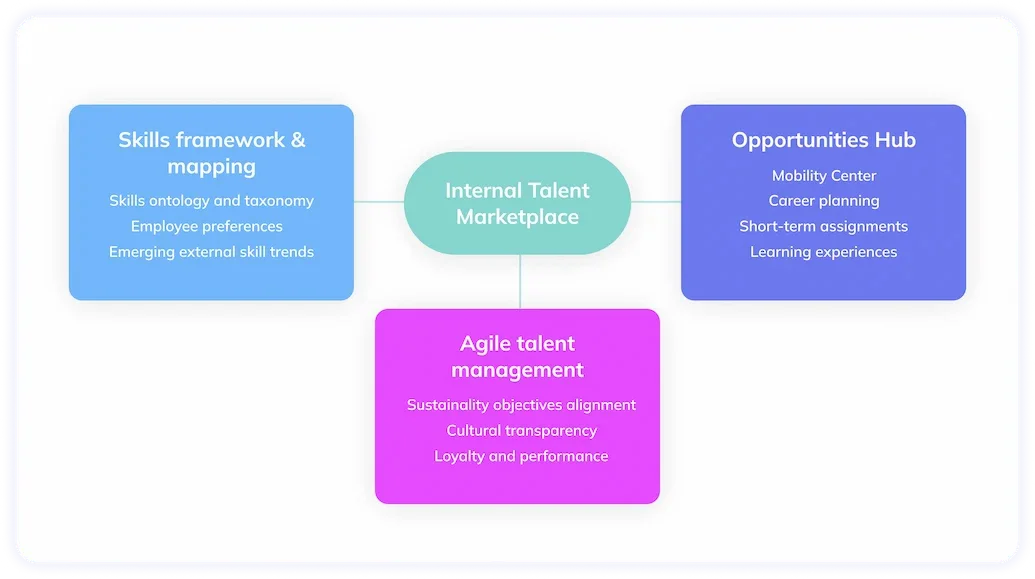All about Internal Talent Marketplace

Are we genuinely facing a skills shortage, or is it a matter of resource misallocation? Are recruitment challenges inevitable? How can we address the escalating disengagement?
1. What is an Internal Talent marketplace?
Definition:
A talent marketplace is a dedicated space within the company that brings together all development opportunities, including internal job postings, training resources, temporary project assignments, mentoring possibilities and more.
Furthermore, it embodies a managerial philosophy in which transparency shapes the new dynamics between employees and their organisation. This collaborative arena relies on artificial intelligence, where individual preferences manifest in personalised recommendations for internal opportunities.
The absence of managerial transparency is frequently cited as a significant factor leading to employee disengagement. Beyond the imperative for objectivity and visibility, there is a pressing need to reconsider the collaborative dimension, which has been recently challenged by physical distancing measures.
Consequently, some HR leaders view the present period as an opportunity to revamp management methods by leveraging employees’ diverse skills, aspirations and developmental projects as avenues for interaction and learning. This innovative form of human collaboration is detailed on the page: “The organization centered around skills.”
What are the areas of an Internal Talent Marketplace?
The composition of a Talent Platform varies depending on the organisation’s maturity level, culture and HR strategy.This intelligent platform includes 5 areas: the space dedicated to mobility, career path planning, short-term assignments or projects, mentorships and, lastly, all training opportunities.
1. Talent Mobility Centre
The Employee Mobility and Engagement platform generates matches by aligning various crucial pieces of information. It correlates employees’ abilities, levels and skills with the selection criteria for available positions within the organisation, aiming to create pertinent matches.
Depending on the specified parameters, talented individuals receive job proposals recommended by artificial intelligence, identifying them as potential candidates for internal recruitment. Furthermore, managers and HR personnel can swiftly pinpoint the best-suited human resources using customised filters
Our webpage provides a comprehensive overview of the mechanisms behind the Talent Mobility Center.
2. Career Planning
Understanding employees’ preferences can pave the way for creating novel career paths. They can construct inspiring career trajectories by visualising the connections between the various aspects of the company’s operations. These pathways are developed using the opportunities collected in their collaborative space, which is accessible to both managers and HR personnel.
Tailored career development is one of the new modalities discussed in our “Building Individualized Career Plans” page.
3. Short-Term Assignment.
The demand for prompt responsiveness to mobilise appropriate resources and the pursuit of enhanced performance through establishing multidisciplinary teams are factors driving the expansion of project-based management within the company. An internal talent platform will render these collaborative formats transparent to employees, equipping managers with the means to swiftly assemble ad-hoc teams when needed.
Project staffing represents a significant aspect of the fresh frameworks for managing highly skilled individuals. This procedure is discussed in detail on our page “Project staffing, tools and methods.”
4. Mentoring
The internal collaborative network thus established offers the chance to connect employees with similar skills, assets and goals. This facilitates the transfer and acquisition of employee skills and enables a more fluid interaction with the realities of various positions, contributing to the preservation of assets and envisioned career progressions.
5. Learning Experiences
According to the Randstad Employer Brand Research 2022, opportunities rank as the 4th most critical criterion when selecting employers. Mere centralisation of training offerings is no longer sufficient. Delivering training content and formats tailored to employees’ preferences is now a key feature of an internal talent optimisation platform. Recent innovations even enable employees to identify training courses that their colleagues find valuable. Do you want to improve the construction of your training plans? Here are some tips: Optimize your training plan.
Do you want to improve the construction of your training plans? Here are some tips: Optimize your training plan.

2. A space dedicated to seizing every opportunity for development
Employees are concerned with their own development

Managers committed to adopting best practices

An organization in search of agility

3. An internal talent marketplace to embrace the future of work
Work organization based on traditional roles is now being called into question. In a Deloitte study on organizational optimization, 81% of HR managers stated that most work is carried out outside the framework of formally defined roles. On a day-to-day basis, job descriptions no longer reflect the reality experienced by employees: they lock in predispositions that are just waiting to be expressed. Collective performance now comes from the agile allocation of tasks to the right internal resources.
This agile approach is praised by G2 in its latest evaluation of Talent Marketplace solutions, the matrix of which is shown below:
The agility of a real-time hub from skills
60% of employees are in favor of internal mobility.
The vitality of a collaborative ecosystem
One of the most promising approaches is to break out of traditional silos and recreate micro-organisations oriented towards solving problems and achieving common goals.These autonomous and temporary entities can redeploy the organization’s assets toward new collaborations. Talent management practices are being reinvented around the skills of employees and are no longer based on the usual links between the functions of the company’s departments.
The new momentum of commitment and performance
1. The employee experience
This invaluable key gains renewed significance by utilizing a collaborative and inspirational platform for individual development. Interests, aspirations and learning preferences are central to this new management approach.
Our philosophy on internal mobility is illustrated through two complementary resources:
- The Webinar with Leyton Group “Internal Mobility: Coping with Talent Shortages.”
- The Guide to making the Mobility of this Population Concrete: “Encouraging the mobility of talents.”
The G2 solutions comparator offers an overview of the best Talent Marketplace solutions based on user reviews. Rate the software here.
2. The quest for performance
Customising development plans introduces a fresh ally to collective performance. Each skill is linked with various training options such as micro-learning, mentoring, MOOCs, practical projects and more, along with corresponding proficiency levels.Consequently, employees can select the most suitable development support, access tailored pedagogical resources and track their progress alongside their manager.
Curious about how to implement this approach? You can find detailed answers on our “Optimizing the training budget” page.
3. Career development
A significant 49% of employees cite the lack of internal career development options as their primary reason for considering leaving their current positions. In the face of challenges related to flexibility and the empowerment to choose one’s career path, these collaborative platforms for visualising opportunities offer innovative solutions and contribute to the re-engagement of valuable talent.
In addition to these advantages, the implementation of an HR strategy cantered on skills also strengthens the objectivity of performance evaluations. It fosters an environment more conducive to diversity and inclusion.
While diversity and inclusion have been widely discussed in the context of recruitment, their role in internal mobility is equally crucial. Find comprehensive insights on this topic on our “Diversity and Inclusion in Internal Mobility” page.
4. Conditions to be met to deploy a Talent Platform
These collaborative spaces offer a chance to explore an alternative perspective on work that aligns more closely with employees’ expectations and caters to current performance demands. This profound transformation also necessitates a high level of maturity concerning knowledge management, managerial culture and the organisation’s dedication to fostering the transparency inherent in the upcoming platform.

A database compatible with this evolution
The effectiveness of this HR platform depends on the strength of the HR data that comprise it. In a broader context, the foundations of this technological advancement demand a thorough diagnosis.Here is a non-exhaustive list of considerations: hosting infrastructure, sound data protection and security protocols, historical data retention, and the interoperability of various information systems.
This approach contributes to attaining Smart Data, which we explain further in our “Smart Data HR and data reliability” page.
An architecture of skills
Embracing an internal marketplace entails optimising the potential of connections between skills, motivations, artificial intelligence and machine learning. Among the critical catalysts, the ontology and taxonomy of skills serve as the foundational elements that establish a common language for the platform.
Examples:
- This shared reference system, for example, is the one that supplies your GPEC (Gestion Prévisionnelle des Emplois et des Compétences or Anticipatory Management of Jobs and Skills) with insights derived from analysed level disparities.
- It is also the basis for recognising the skill developed during a training course and will modify the level of the employee’s profile.
You can work in HR and be a bit of a geek! Read our article Taxonomy and Ontology of Your Repositories.
You can work in HR and be a bit of a geek! Read our article “Taxonomy and Ontology of Your Repositories.”The availability of this resource infrastructure is crucial, but it is not enough. Three additional prerequisites need to be emphasised:
- Incorporate external data by monitoring emerging skills within the industry and those possessed by competitors.
- Utilize semantic analysis of employee profiles and experiences to propose skills that may not be present in the existing repositories.
- Leverage user behaviors to continuously enhance the software intelligence’s suggestions.
All the recent features and advances in AI are listed on our page: “AI for Talent Management.”
The primary assurance for the success of the skills optimisation platform directed towards employees is the establishment of a system for formalising, updating and adopting internal skills data. This initial phase is comprehensively detailed on our page: “All about repositories” at skills.
An opportunity for cultural and managerial change
Benoît Serre, Deputy Vice President of ANDRH, describes corporate culture as the outcome of interactions among its members.Undoubtedly, the collaborative model ingrained in the intelligence platform described here influences the behaviors of employees, HR professionals and managers.
What are the requirements for making the transition to an intelligent talent management platform?
- Be committed to and utilise a professional skills system.
- Recognise employees’ willingness to engage in projects outside their primary roles.
- Implement a performance evaluation system that fosters the growth of professional skills.
- Operate within an organization committed to breaking down silos.
- Consider collaboration between HR, IT, digital and different business units as an opportunity and allocate the requisite resources.
Which mentalities are needed among managers and employees?
- Managers may be tempted to view the transfer of a team member to another team as a constraint. Therefore, there is a need for a pedagogical effort to emphasize the importance of retaining talent as a priority. Additionally, the organizational culture must evolve to regard the sharing of skills as a collective opportunity.
- For employees, fostering a mindset of autonomy in career development encourages them to actively seek internal opportunities. Simultaneously, they should be able to articulate their motivations to strengthen existing skills and acquire new ones.
What does this model mean for the HR function?
- Performance Evaluation: How can the expansion of activities and participation in multiple projects be effectively integrated into overall performance assessments? Does promoting mobility necessitate setting a minimum level of engagement? How can we transition from a single manager-conducted evaluation to multiple simultaneous evaluations?
- Management Model: How can multiple managers collaborate in supporting an individual? What steps should be taken in cases of conflicts regarding activity prioritization?
- Quality of Work Life: How can we prevent excessive workloads and the potential risks of burnout?
- Compensation: Should multitasking be financially rewarded? How can we establish a system that combines compensation based on objectives and skill acquisition?
- HR Development: How can training programs be managed to incorporate new development opportunities such as mentoring and learning during short projects?
- Skills Governance: How can we align the response to employees’ development aspirations with the strategic workforce planning challenges related to key skills and resource planning?
Conclusion: The opportunity to rethink today’s work
The new mobilisation model helps to decompartmentalize the movement of internal resources. Former prerequisites like a specific level of seniority, being on the list of top potentials, or requiring managerial approval to change roles are no longer applicable.
Previous formalities had been constraining career paths and negatively impacting performance, talent retention and the company’s overall attractiveness.These new collaborative spaces allow employees to translate their skills into cross-functional, meaningful activities aligned with their aspirations. Improved visibility and transparency redefine the relationship between talent ability and the organisation. Managers can optimise resource allocation by emphasising a department’s design as a collection of projects.
Many conditions are essential for the successful transition to agility:
- Firstly, it’s important to unveil skills that aren’t yet in the repositories or haven’t been fully utilized, empowering employees in the process.
- Secondly, the technological aspect offered by AI and Machine Learning should be viewed as an accelerator, and fostering a positive perception of these technologies is crucial. Trust issues surrounding AI persist, often stemming from a fear of change. An educational effort and concrete presentation of its use cases can enhance understanding of the opportunities presented by this technology.
- Lastly, there are numerous cultural implications for managers and process-related consequences for the HR function. Anticipating these issues and assembling a team and partners for support is highly advisable.
FAQ
- How many months does it take to build a talent marketplace?It all depends on the maturity of your skills management system: have you defined the skills required for each position? Are employees reliably assessed? Is your training linked to skills acquired? The aim is to start with an initial Proof of Concept, which can be implemented in less than 6 months thanks to the support methodology of a partner like Neobrain.
- What are the real benefits of such a platform?This platform matches internal opportunities based on a variety of factual criteria, such as skills and motivations: the result is greater objectivity and sustainability in internal recruitment. A company like Natixis has increased its internal recruitment by 60%.
Moreover, the instantaneous creation of project teams better meets employees’ desire for “real-life” learning, as they can develop new skills skills without going through an exhaustive training cycle.
- Can we mobilize freelancers on a Talent Marketplace?The very nature of this tool is to offer companies great flexibility in assigning the skills needed for their projects, whether in-house or by calling on external talent. However, this requires that freelancers’ profiles be registered and enhanced with their specific expertise.
Do you still have questions ?
Please feel free to contact us for more information 😃




